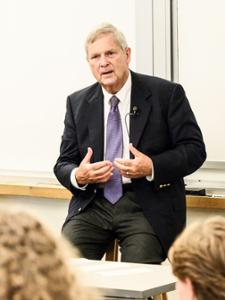
Environmental Studies
The goals of the Hamilton College Environmental Studies Program are to provide students with the knowledge, skills, and interdisciplinary perspectives to understand the causes and consequences of, as well as potential solutions to, the world’s pressing environmental challenges, and to enable them to become environmentally conscious citizens.
About the Major
Environmental Studies addresses the challenges of creating a just and sustainable future in the face of the climate crisis, environmental problems, and inequality from local to global scales. At Hamilton, students in Environmental Studies work with interdisciplinary faculty in environmental justice, environmental data science, and climate change, as well as with faculty from other disciplines to develop the skills and perspectives needed to tackle these problems.
Students Will Learn To:
- Explain the causes of, impacts of, and potential solutions to climate change
- Analyze how history, power, and identity shape environmental justice
- Apply appropriate research methods to answer a research question about a pressing environmental problem
A Sampling of Courses

Changing Arctic Ecosystems
An examination of the primary literature on environmental and climate change in Arctic and sub-Arctic ecosystems. We will investigate the interplay between anthropogenic, physical, and biological processes in high latitude regions. We will explore current research on the cycling of water, carbon and energy throughout high latitude ecosystems and the potential for these regions to amplify global climate change.
Explore these select courses:
Archaeology offers the opportunity to examine social-ecological systems over long time scales. This course explores different ways of conceptualizing these systems and considers major topics such as: decreasing biodiversity, traditional ecological knowledge, human-environment interactions related to food production, social responses to natural disasters and climate change, and resilience and collapse of past societies. We’ll engage with discussions on sustainability and our ecological impact on the environment.
This course will focus on the application of statistical programming for big data associated with ongoing environmental issues. Students will gain experience in statistical programming throughout the entire data life cycle including data management and provenance, analysis, visualization, and communication. Students will learn the fundamentals of applying statistical modelling and machine learning for making predictions and inferences for environmental data. Students will also learn considerations of data science that are unique to environmental data including spatial, temporal, ethical, and justice concerns. Environmental topics will include climate change, pollution, natural disasters, and agricultural impacts.
Meet Our Faculty
climate change, carbon accounting, climate resilience, renewable energy, and coastal and marine systems
Native and Indigenous Studies, Environmental Justice, Climate Change studies, Animal Studies, and Environmental Humanities
Environmental philosophy (esp. environmental justice & Indigenous environmental philosophy), decolonial philosophy, soundscape studies, hermeneutics, and philosophy of race
Nathan Goodale
William R. Kenan Jr. Professor of Anthropology, Associate Vice President for Academic Affairs, Co-Director of Geoarchaeology
complex hunter-gatherers in the interior Pacific Northwest; the forager/farmer transition in Southwest Asia; rural coastal adaptations in western Ireland
environmental data science, ecohydrology, ecology, and geospatial analysis
Romantic period literature; animals in literature; animal rights; nature writing – literature and environmentalism; cultural and political history of the Adirondack Park
conservation biology, agroecology, ornithology, Nearctic-Neotropical migratory birds, and ecotoxicology
food system, regenerative agriculture, soil health science, plant nutrition, climate-smart farming, reclamation agriculture for underserved communities, community engagement, food business, entrepreneurship, food safety
behavioral ecology, disease ecology
Faces & Spaces
The Taylor Science Center houses the offices for many faculty members in environmental studies. The complex contains an atrium with a coffeehouse, an auditorium, a greenhouse, and more than 100 teaching and student research laboratories.





Careers After Hamilton
Hamilton graduates who concentrated in environmental studies are pursuing careers in a variety of fields, including:
- Corps Member, Teach for America
- Chair, Department of Rheumatology, Cleveland Clinic
- Trip Leader, Naturalists At Large
- Alaska Representative, Defenders of Wildlife
- Policy Coordinator, National Oceanic & Atmospheric Administration
- Clinical Research Coordinator, Dana-Farber Cancer Institute
- Program Assistant, Natural Resources Defense Council
Explore Hamilton Stories

Kudos! Recent Student Accomplishments
The 2023-24 academic year wrapped up with the awarding of national fellowships and scholarships. Clare Robinson ’25, an environmental studies major from Philadelphia, received a $7000 Udall Undergraduate Scholarship.

Students’ Business Wins Grand Prize in Statewide Competition
Ellie Sangree ’24, an environmental studies major, and Jesse Wexler ’24 have teamed up and combined their respective science and business acumen to revolutionize the future of clean water.

Tracking Climate Change Through AI
Artificial intelligence and climate change are among the very foremost hot-button issues of today. This summer, a project by Adam Koplik ’25 and Assistant Professor of Environmental Studies Heather Kropp is using one to explore the other—by employing machine learning to measure vegetation change in the Arctic.
Contact
Department Name
Environmental Studies Program
Contact Name
Aaron Strong, Program Director
Clinton, NY 13323











